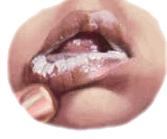
What is Oral Thrush?
Oral Thrush is an infection usually limited to the mucous membranes of the mouth and tongue. Oral thrush is also known as oral candidiasis from the yeast-like fungal organism, Candida albicans, that is causing the infection (although other related Candida species may be involved). Candida albicans is the same fungus that causes vaginal yeast infections in women and diaper rash in infants.
Oral Thrush • Oral Candidiasis
When Candida albicans, which can be found normally in our mouth, starts growing out of control the resulting mouth infection is called oral thrush.
Oral thrush or oral candidiasis is a surface infection of the mouth that can affect the insides of the cheeks, the tongue, gums, palate and throat, causing painful lesions. Although oral thrush can affect anyone, it occurs most often in babies, older adults, and in people with compromised immune systems.
Oral Thrush (aka thrush mouth) is not a dangerous condition for people with good general health. With proper medical treatment, most simple thrush infections can be cured in about 7 to 14 days. However, in patients with severe immuno-deficiencies (HIV positive or receiving chemotherapy), if untreated, the infection can spread to other organs, like the esophagus and lungs, or throughout the body, which can be fatal.
Oral Thrush Symptoms - What does oral thrush look like
The following oral thrush symptoms characterize the most usual form of the condition (Acute Pseudomembranous Candidiasis).
- Slightly raised white patches on the mouth are the common symptoms of oral thrush. Usually these beginning signs of oral thrush can be first seen on the tongue, and spread to the inside of the cheeks, the palate, under the tongue, and in the throat.
- Scraping off the white surface of the patches, reveals a red, inflamed area that may bleed slightly.
- Normally there is only mild pain. But sometimes oral thrush lesions become painful, especially if their surface is scraped or they get irritated during brushing or eating. The lesions can slowly increase in number and size.
Symptoms of other forms of oral thrush are :
- Chronic Hyperplastic Candidiasis : asymptomatic white plaques that are adherent and do not scrape off
- Chronic Atrophic (Erythematous) Candidiasis : red patches or velvet textured plaques (usually under dentures)
Some other symptoms of oral thrush include burning pain in the mouth or throat and altered or reduced taste. When oral thrush spreads to the throat, it can cause sore throat, difficulty in swallowing and, in case of a more serious infection, fever. Sometimes, oral candidiasis can cause the corners of the mouth to become chapped, cracked, and sore angular cheilitis).
Babies can develop thrush in the first few weeks of life. The thrush symptoms are similar with those in adults. Babies may be fussy, cry or seem irritated during feedings.
What does oral thrush look like : For pictures of oral thrush click here
Diagnosis of Oral Thrush
The diagnosis of oral candidiasis is usually based on its clinical appearance with the distinctive white lesions on the mouth, tongue, or cheeks, during a visual examination of the mouth. If in doubt, your doctor or dentist may refer you to an Oral Pathologist to get a microscopic histological examination or a culture of intraoral scrapings to identify the Candida species and rule out other illnesses in order to confirm the diagnosis. In severe cases, when it is suspected that the infection has spread beyond the throat, an endoscopic examination may be required to check for the extend of the infection.
If a patient has frequent or persistent outbreaks of oral thrush symptoms, the doctor or dentist may recommend additional diagnostic tests to check for undiagnosed medical illness, such as diabetes, cancer or HIV infection. A biopsy of affected tissue may be indicated, especially when candidiasis is suspected in conjunction with some concurrent pathology, such as epithelial dysplasia, squamous cell carcinoma, or lichen planus.
What Causes Oral Thrush
Oral Thrush is caused by the growth of Candida albicans. Although Candida albicans is a type of fungus naturally found in most of the healthy mouths, its overgrowth can cause an outbreak of oral thrush symptoms. The Candida albicans population in the mouth is kept under control as it is competing with the other bacteria and micro-organisms of the mouth.
Any condition that changes the natural balance of the microbial ecosystem of the mouth can potentially be the reason for an oral thrush infection. The causes of oral thrush are conditions that either affect the immune system or alter the oral mucosal environment.
Immune system related causes of oral thrush
- A weakened immune system increases the chances of developing thrush, because of reduced ability of the body to control viruses,bacteria, or fungi and to stop infections.
That is why oral thrush symptoms are common in elderly people and babies, as they have in general a weaker immune system and they are more susceptible to infections.
Population groups with a weakened immune system include :
- persons with poor general health,
- cancer patients receiving radiation therapy/chemotherapy
- people infected with HIV/AIDS
- having Hypothyroidism or Hyperparathyroidism
- taking drugs to suppress the immune system following an organ transplant
Thrush can be very serious for patients with cancer or HIV as it further weakens the immune system and, if allowed to spread into the throat, affects their nutrition and causes respiratory problems.
Oral mucosa environment related causes of oral thrush
- Taking antibiotics or steroids may alter the oral mucosal environment by suppressing certain species of mouth bacteria in favor of others, one of which might be Candida albicans, leading to oral thrush.
- Another common cause of oral thrush symptoms is xerostomia or dry mouth syndrome. People with dry mouth have less saliva which disrupts the chemistry of the mouth and may help in developing an oral candidiasis infection.
- Poor oral hygiene, heavy smoking, excessive alcohol consumption, stress and certain medications that change the chemical balance of the mouth may have the same effect.( causing the fungus Candida to grow out of control, causing infection)
- Patients with diabetes have saliva that contains large amounts of sugar, which encourages the growth of Candida..
- Wearing dentures that are not properly maintained or fitted can be responsible for some type of oral thrush.
- A newborn may acquire the Candida fungus during delivery, if the mother had an active vaginal candidiasis. Symptoms of oral thrush usually follow within 7 to 10 days after birth.
![]() The cost involved with dental treatments can be significant and many patients may not afford it if they are not covered by their dental insurance.
Learn how to choose a dental insurance plan that will provide the best dental treatment to you and your family.
The cost involved with dental treatments can be significant and many patients may not afford it if they are not covered by their dental insurance.
Learn how to choose a dental insurance plan that will provide the best dental treatment to you and your family.


